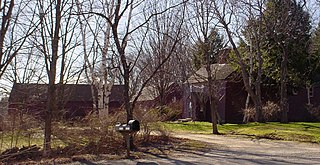
The John Sedgley Homestead is a historic homestead property at Scituate and Chases Pond Road in the York Corner area of York, Maine. Its oldest structure built in the late First Period, probably c. 1715, it is the oldest homestead in the State of Maine that is still in its original setting. Historically the homestead included a cape, farm home, carriage house, stables building, two outbuildings, and a large land holding, all of which is still existing today. The property was listed on the National Register of Historic Places in 1976.
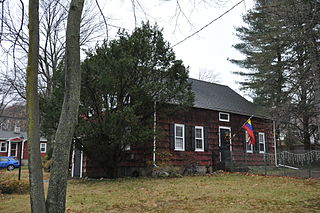
The Samuel Ferris House is a historic house at 1 Cary Road in Greenwich, Connecticut. Built around 1760 and enlarged around 1800, it is a well-preserved example of a Colonial period Cape, a rare survivor of the form to still stand facing the Boston Post Road in the town. It is also locally significant for its connections to the Ferris family, early settlers of the area. The house was listed on the U.S. National Register of Historic Places in 1989.
The Salome Sellers House is a historic house museum at 416 Sunset Road in Deer Isle, Maine. Its oldest portion dating to the 1770s, the house is locally distinctive as a well-preserved 19th-century Cape, and as the home of Salome Sellers, one of Deer Isle's longest-lived residents (1800-1909). The house has been a museum property of the Deer Isle-Stonington Historical Society since 1960, and is believed to be the only house of its type in the state that is open as a museum. It was listed on the National Register of Historic Places in 1983.
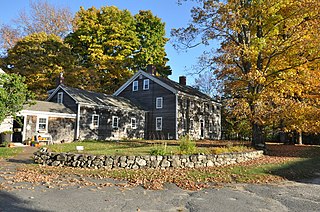
Hall's Tavern, also once known as the Falmouth Tavern, and now the Quaker Tavern B&B and Inn, is an historic tavern at 377 Gray Road in Falmouth, Maine. Built about 1800 as a private home, it served for many years of the 19th century as a traveler accommodation, and is one of Falmouth's few surviving buildings of the period. It was listed on the National Register of Historic Places in 1978.
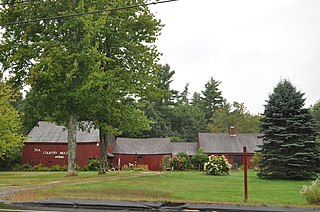
The Eaton House is an historic house on Sanford Road in Wells, Maine. Built in the late 18th century, it is one of a collection of well-preserved 18th-century Cape style houses in Wells. It was listed on the National Register of Historic Places in 1979, listed as being in the North Berwick area. However, it is physically located in the town of Wells.

The McClure-Hilton House is a historic house at 16 Tinker Road in Merrimack, New Hampshire. The oldest portion of this 1+1⁄2-story Cape style house was built c. 1741, and is one of the oldest surviving houses in the area. It was owned by the same family for over 200 years, and its interior includes stencilwork that may have been made by Moses Eaton Jr., an itinerant artist of the 19th century. The property also includes a barn, located on the other side of Tinker Road, which is of great antiquity. The property was listed on the National Register of Historic Places in 1989.
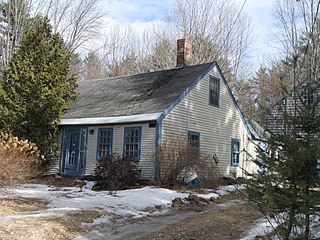
The House by the Side of the Road is a historic house at 61 School Street in Tilton, New Hampshire. The house, built c. 1783, is a modest 1+1⁄2-story Cape style house that is five bays wide, with a center entry and a central chimney. The house is locally notable as the home of poet Sam Walter Foss in 1877–78, when he was attending Tilton Seminary, and has been known as the "House by the Side of Road" after Foss's poem of the same name, since the 1890s. The house was listed on the National Register of Historic Places in 1980.

The Nutting Homestead is a historic farm complex on Maine State Route 121, south of the center of Otisfield, Maine. The property has been owned by the Nutting family and its descendants since the late 18th century and exemplifies the adaptive use of farm properties over time. The oldest portion of the farmhouse dates to 1796, and other buildings in the complex date mainly to the 19th century. The property was listed on the National Register of Historic Places in 1974.
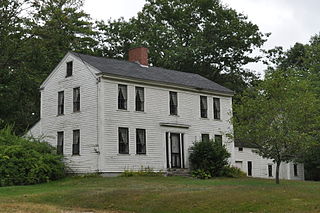
The Watkins House and Cabins are a history property at the junction of Raymond Cape Road and United States Route 302 in Casco, Maine. The property exemplifies the adaptive alteration and reuse of properties for different purposes over a 200-year period in southern Maine. The property is 13 acres (5.3 ha) in size, much of which is now woodland and pasture. The developed portion of the property includes two houses, one of which dates to the early 19th century, a barn, and three small cabins, as well as the remains of a carriage factory. The property was listed on the National Register of Historic Places in 1992.
The Burgess House is a historic house on Burgess Road, just east of Austin Road in Sebec, Maine, United States. The oldest portion of this wood-frame house dates to about 1816, and was built by Ichabod Young, who erected the first fulling mill in Piscataquis County. The house is most remarkable for its high-quality interior woodwork, and for the artwork on the walls of several of its rooms, which includes paintings by Rufus Porter and stencilwork by Moses Eaton, Jr., two noted itinerant artists of the early-to-mid 19th century. The house was listed on the National Register of Historic Places in 1978.
The Peter Powers House is a historic house on Sunshine Road, just east of Maine State Route 15 in Deer Isle, Maine. This 1+1⁄2-story Cape style house was built in 1785 for Rev. Peter Powers, the first settled minister of the town, and is the oldest surviving house in the town. It is also architecturally distinctive as a rare regional example of a gambrel-roofed Cape. The house was listed on the National Register of Historic Places in 1980.

The Early Cape houses of Wells, Maine, are a collection of 18th-century Cape style houses in or near the town of Wells, Maine. The town has a concentration of these houses that is unusual in the state of Maine. In the 1970s the town conducted a detailed street survey, in which 19 historically significant 18th-century Cape houses were identified either in or just outside the municipal boundaries. These buildings were subsequently listed on the National Register of Historic Places in December 1979.

The Morrell House is a historic house on Morrills Mill Road in North Berwick, Maine. Built in 1763 by a descendant of one of the area's first European settlers, it is a fine local example of Georgian craftsmanship. It was listed on the National Register of Historic Places in 1976.
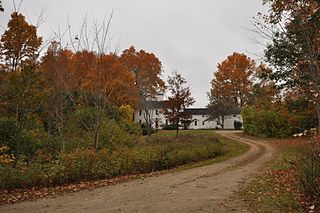
The James Smith Homestead is a historic house on 5 Russell Farm Road in Kennebunk, Maine. Built in 1753, it is one of the few surviving mid-18th century inland farmhouses in the town. It was listed on the National Register of Historic Places in 1982, and is included in the Lower Alewive Historic District.

The Dyer–Hutchinson Farm is a historic farm property at 1148 Sawyer Road in Cape Elizabeth, Maine. Established about 1790, it is one of the few surviving 18th-century farms in the town, and was in the hands of two families for about 200 years. It is now operated as the Old Farm Christmas Place, with some of its land devoted to the cultivation of Christmas trees. The property was listed on the National Register of Historic Places in 1997.

The William Colburn House is a historic house at 91 Bennoch Road in Orono, Maine. It was built about 1780 by William Colburn, one of the area's first white settlers, and is one of the few 18th-century houses surviving in Maine's central interior. It was listed on the National Register of Historic Places in 1973.
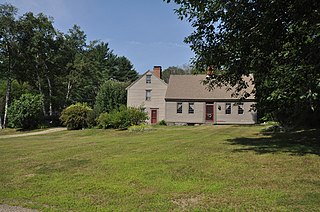
The Robert Reed House, also known as the Robert P. Tristram Coffin House, is a historic house at Chop Point Road and Maine State Route 128 in Woolwich, Maine. Built in 1765, it is one of the area's oldest houses, and a distinct example of two period houses that have been joined. The house is also notable as the home of the Pulitzer Prize-winning poet Robert P. Tristram Coffin. It was listed on the National Register of Historic Places in 1982.

The Godfrey Ludwig House is a historic house on Maine State Route 32 in Waldoboro, Maine. Built about 1800, it is a well-preserved brick Cape house, built by a descendant of one of the area's early German immigrants. It is notable for features enabling its use as a church. It was listed on the National Register of Historic Places in 1980.

Parson's Bend is a historic farm property on Nelson Street in Alna, Maine. Built about 1800, the farmhouse is a well-preserved and idiosyncratic Georgian-Federal style Cape house. It was listed on the National Register of Historic Places in 2005.
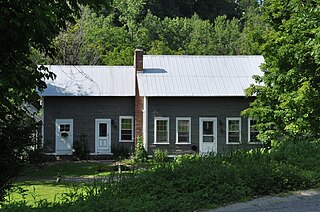
The Royalton Mill Complex is a three-building residential site in what is now a rural setting of Royalton, Vermont. The two houses and barn are historically associated with a mill, whose breached dams and remnant foundations lie just to the north. One of the houses, built about 1780, is believed to be Royalton's oldest surviving building. The complex was listed on the National Register of Historic Places in 1983.



















